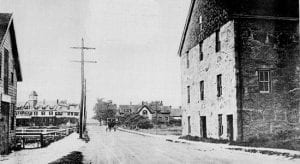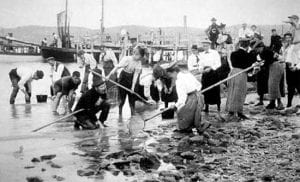Scientific Community in Woods Hole
Woods Hole is a world center for marine, biomedical, and environmental science. Its reputation in this broad field may seem out of proportion to its small size, yet, in addition to several smaller enterprises and labs, Woods Hole contains two large private organizations (the Marine Biological Laboratory and the Woods Hole Oceanographic Institution) and two federal government facilities (the National Marine Fisheries Service and the U.S. Geological Survey). Together, these larger institutions occupy some 170 buildings, operate a dozen research vessels and collecting boats, employ more than 1,500 year-round people, and offer instruction to approximately 500 students.
History of the Scientific Community in Woods Hole
The village of Woods Hole was settled more than 300 years ago and for two centuries remained primarily a farming and fishing community. Then in 1871 the United States Commission of Fish and Fisheries (precursor of the National Marine Fisheries Service) was established, and its first director, Spencer Fullerton Baird, set up a temporary collecting station in Woods Hole to study marine animals. Attracted by the abundance of fauna and unpolluted waters, he established a permanent laboratory in the village in 1875. Soon, visiting scientists were studying local marine plants and animals, and a hatchery was organized to stock rivers with shad, salmon, and other fish. At about the same time, the Fish Commission acquired Albatross, a 234-foot steamer and the first American ship to be designed and built as a research vessel.
In 1888, a second institution, the Marine Biological Laboratory (MBL), was established across the street. Its founders believed that some of the essential processes of life, such as cell division, nerve and muscle activity, and development, might be studied more easily in simple marine forms than in higher animals. Consequently, both teaching and research were begun in cellular biology, embryology, and biomedical fields as well as in marine biology in general. For almost 90 years MBL was solely a summer institution, but since the 1970s it has housed a number of major year-round programs.
The Woods Hole Oceanographic Institution (WHOI), a private nonprofit organization originally funded by the Rockefeller Foundation, struck off in a somewhat different direction. It was incorporated in 1930 to study all branches of oceanography. Since much of the research was planned for the deep sea, the research vessel Atlantis was built and used from 1931 to 1964. In its first decade, WHOI was primarily a summer institution. During World War II it changed to a year-round operation to gather oceanographic information for anti-submarine warfare, amphibious landings, and other operations. After the war, WHOI continued to work with the government, and at present 80 percent of its annual budget is supported by federal grants and contracts.
In the 1960s, the Fisheries and MBL replaced old wooden buildings with a new aquarium and modern laboratories; WHOI expanded its research programs and facilities and established a graduate education program in concert with Massachusetts Institute of Technology (MIT). A fourth institution, the U.S. Geological Survey, headquartered its new Branch of Atlantic Marine Geology here to investigate the geology and geophysics of the Atlantic, Gulf of Mexico, and Caribbean. The Sea Education Association joined the community in 1975, and Woods Hole Research Center in 1985.
Marine Biological Laboratory (MBL)
The Marine Biological Laboratory (MBL) is an international center devoted to improving the human condition through basic research and education in biology, biomedicine, and environmental science.
National Marine Fisheries Service (NMFS)
The National Marine Fisheries Service's Woods Hole Laboratory conducts research on fisheries resources and the fishermen who harvest them, and on marine mammals and other protected resources in the Northwest Atlantic Ocean.
Sea Education Association (SEA)
Sea Education Association (SEA) has been a leader in marine education, developing an understanding of the importance of the ocean and of its powerful role in seemingly every aspect of our lives.
United States Geological Survey (USGS)
Earth scientists at the U.S. Geological Survey's Woods Hole Science Center explore and study the geology, chemistry, and physics of the underwater areas offshore of the United States.
Woods Hole Oceanographic Institution (WHOI)
The Woods Hole Oceanographic Institution (WHOI) is a private, nonprofit research and higher education facility dedicated to the study of all aspects of marine science and engineering and to the education of marine researchers.
Woods Hole Research Center
The Woods Hole Research Center was founded in 1985 to address global environmental problems. The 40-member staff engages in scientific research, global environmental policy, and education.

Water Street, early 1900s. Candle House at right dates to Woods Hole whaling days (1828 to 1864). Fisheries building is at left in background. (NEFSC Photo Archives)

MBL botany class students during an 1895 specimen collection trip. (MBL Collection)

